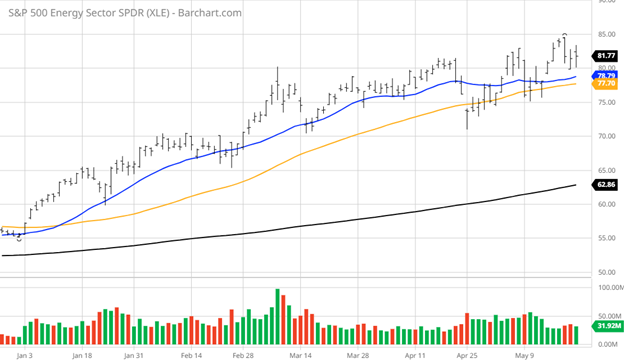Spotlighting Stable Assets With Inflation-Fighting Yields
Bearish sentiment has ruled over the stock market, resulting in seven straight weeks of losses. The technical charts are showing severe damage, and the 200-day moving averages for all the major averages are now turning lower.
The market as a whole needs some game-changing headlines to reverse the trend — be it peak inflation, the removal of Vladimir Putin and/or Xi Jinping from power, a Russian withdrawal from Ukraine, evidence of supply chains rapidly opening or Joe Biden discarding his current, restrictive domestic energy policy. Any of these or a combination of them would be huge.
The problem with this layout of hopeful catalysts is that none of them are likely to occur anytime soon. The market likely rallied off of its lows on Friday as a result of triple-witching options, expiration-related buying and professional short-covering going into the weekend. After all, headline risk is always present.
Some evidence of seller exhaustion has to surface before the current downtrend will reverse itself. Heavy trading volume on down days and light volume on up days has to change to reflect bigger buying on up days and lighter volume on down days. Until this pattern is broken, the path of least resistance is lower.
One silver lining is the second-quarter outlook for gross domestic product (GDP) is now at 2.4% according to the Atlanta Federal Reserve. That’s a far cry better than the -1.9% final read on the first quarter of 2022. Companies are maximizing technologies to sustain profit margins as best they can, but there is margin erosion in Q2 for sure.
A second tea leaf of optimism is Bank of America’s Bull & Bear Indicator, a contrarian signal where bearishness gets so extreme that it’s actually bullish for stocks in the short-term. The S&P 500 briefly registered a year-to-date loss of more than 20% during Friday’s session before it rallied in the last hour of trading. It is crucial for the S&P to re-take the 4,200 level in short order or risk a resumption of downside momentum fueled by accelerating redemptions and short-selling by hedge funds.
Going forward, without some sort of collective breakthrough on the various fronts of contention that are keeping inflation elevated, the market’s breadth will likely remain very narrow. The only sectors showing bullish trends at this point are energy, seagoing shipping, specialty chemicals, insurance and big pharma. Investors are hard pressed to find stocks in other sectors that are bucking their downtrends.
In a market such as the present, investing for income can be just as daunting as it is for equities. Here, too, the choices of what’s working and what isn’t are very clear. Investment-grade corporate bonds with maturities of five years are less are about the only decent consideration for venturing into fixed income. The current spot rate for five-year, high-quality corporate bonds is 3.53%, about 1% higher than the highest-paying, five-year certificate of deposit (CD) rate, and with no penalty to sell.
The energy sector still offers the highest dividend yields with emphasis on mid-stream operators of oil and gas infrastructure and pipelines. Here, dividend yields range from 5-8%, depending on the use of leverage by some of the funds and exchange-traded funds (ETF). Some of the ocean shipping stocks offer huge dividend yields, but they have a history of extreme movement in share prices. And a handful of business development companies (BDCs) that own portfolios of floating rate loans have proven themselves to be fairly stable in today’s market. Their dividend yields can get up to around 10% in some cases.
There are at least 50 big-cap stocks with dividend yields above 5%, but many have busted charts. Since the underlying stocks are in protracted downtrends, this lifts the dividend yields. But careful stock selection in a market where the economy is slowing will offer up safe dividend payouts and reasonably stable share price action in iron ore, copper, tobacco, telecom and specialty real estate investment trusts (REITs).

And never underestimate the power of income generation from the active use of selling covered calls on stocks within those few bullish sectors as an excellent way to skin the inflation cat if executed properly. Selling out-of-the-money calls on shares of the very bullish Energy Select Sector SPDR ETF (XLE) can add an additional 5-6% of annual yield to the existing 3% dividend yield the shares pay out.
Until annual inflation starts to decline from its current 8.3% rate, generating yield that can compete with inflation will be a serious challenge and require creative portfolio composition and hands-on active management. That’s just the world we live in. For investors who are depending on stock market gains to peel off 7-10% per year in managed distributions without upsetting their principle, they need to rethink their strategy. After all, there is no timeline on how long or low this current downtrend will last.

